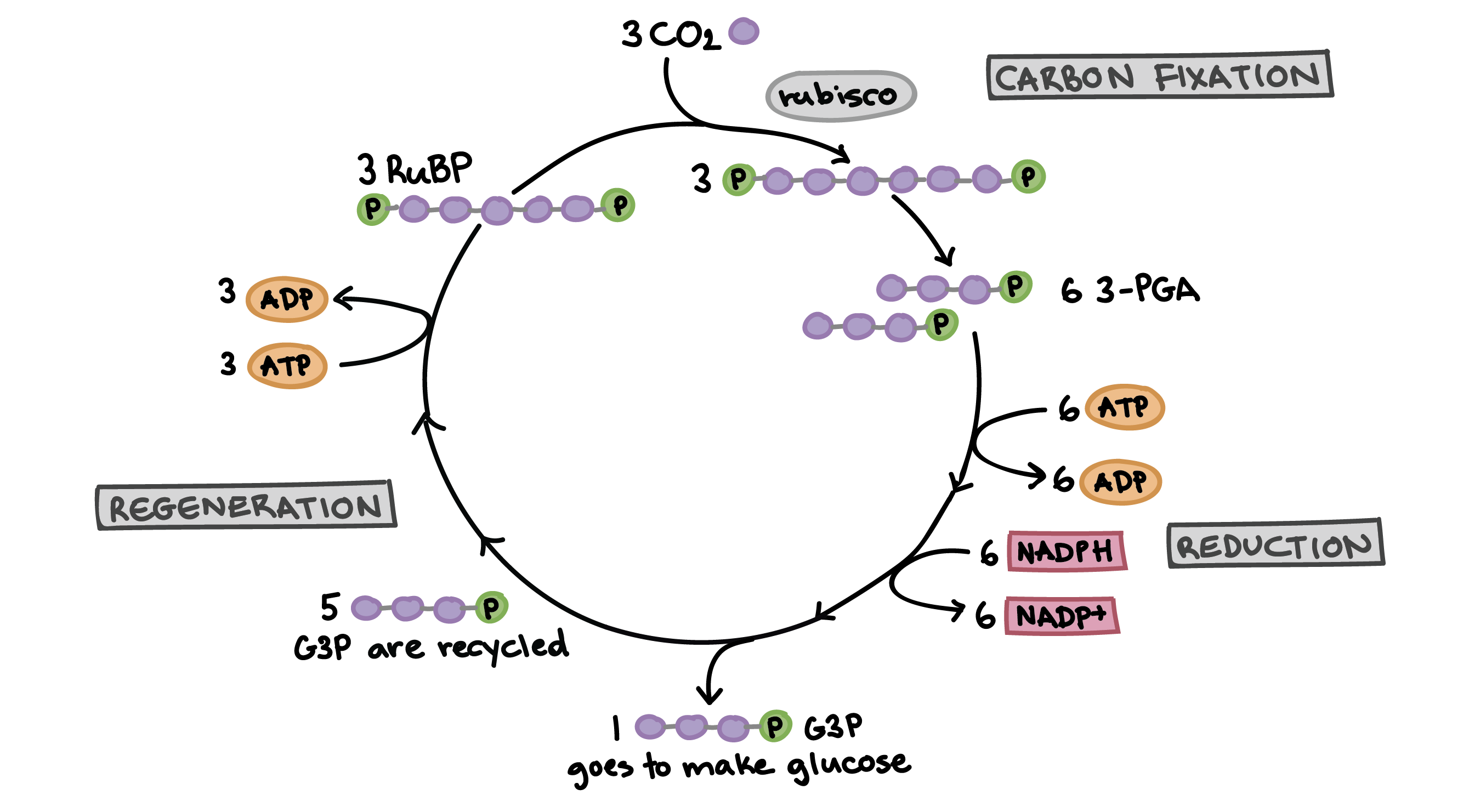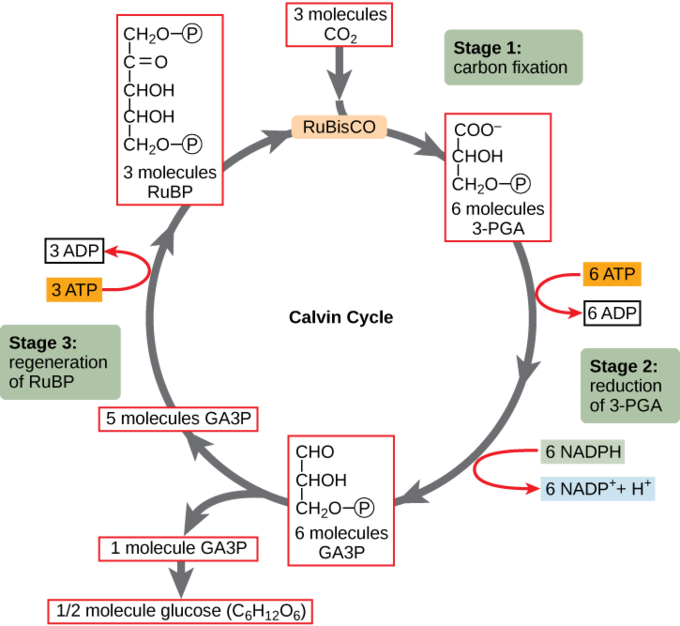Describe the Three Stages of the Calvin Cycle
C3 and C4 Pathways. In stage 2 the organic molecule is reduced.

Calvin Cycle Consists Of Three Phases What Are They Explain The Significance Of Each Of Them
This helps in more carbon dioxide fixation.

. Arrow_forward Describe the three steps of the Calvin cycle and whenATP andor NADPH is needed. The Calvin cycle is organized into three basic stages. Fixation reduction and regeneration.
13 Where does Calvin cycle takes place describe its three phases. What Is The First Step Of The Calvin-benson CycleIn fixation the first stage of the Calvin cycle light-independent reactions are initiated. Stage 1 is the fixation of CO2 with ribulose 15-bisphosphate and the subsequent formation of 3-phosphoglycerate.
The Calvin cycle reactions Figure 2 can be organized into three basic stages. In stage 3 RuBP the molecule that starts the cycle is regenerated so that the cycle can continue. In the Calvin cycle carbon atoms from are fixed incorporated into organic molecules and used to build three-carbon sugars.
In stage 2 the organic molecule is reduced. It is the fixation of C O 2 into a stable organic intermediate. In this C O 2 is utilised for the carboxylation of RuBP.
In carbon fixation the first stage of the Calvin cycle is light-independent reactions. In the stroma in addition to CO 2 two other chemicals are present to initiate the Calvin cycle. 9 Where does the Calvin cycle occur Chapter 10.
Describe the three phases of the Calvin Cycle and how the products of the light-capturing reactions participate in this process. RuBP has five atoms of carbon and a phosphate group on each end. A Car-boxylation during which atmospheric CO 2 combines with 5-C acceptor molecule ribulose 1 5-bisphosphate RuBP and converts it into 3-phosphoglyceric acid 3-PGA.
Unlike the light reactions which take place in the thylakoid membrane the reactions of the Calvin cycle take place in the stroma the. This form a six carbon molecule which is further broken down create two PGAs with three carbons. CO2 is fixed from an inorganic to an organic molecule.
In stage 1 the enzyme RuBisCO incorporates carbon dioxide into an organic molecule. The Calvin cycle has three stages. The Calvin cycle is part of photosynthesis which occurs in two stages.
In the second stage Calvin cycle or dark reactions carbon dioxide and water are converted into organic molecules such as glucose. Please mark as brainliest. ATP and NADPH are then converted into ATP and NADP.
During the carbon fixation stage of the Calvin cycle organic molecules are formed. 12 Where does Calvin cycle take place Class 11. What are the 5 steps of the Calvin cycle.
The enzyme RuBisCO catalyzes the reaction of carboxylation of ribulose-15-bisphosphate RuBP which is a 5-carbon compound by carbon dioxide in a two-step reaction. The Calvin cycle has three stages. An enzyme abbreviated RuBisCO and the molecule ribulose bisphosphate RuBP.
Carbon dioxide fixation Carbon dioxide reduction and Regeneration of RuBP. In the second stage of the C3 cycle ATP and NADPH reduce 3PGA to G3P. 8 Where does the Calvin cycle of photosynthesis take place quizlet.
The C3 pathway is the Calvin cycle. The various steps involved in the Calvin cycle are. The most important enzyme that is involved in the Calvin cycle is called RuBisCO.
The calvin cycle can be thought of as taking place in three stages. RuBP is important because of the carbon fixation that it. Describe the three phases of the Calvin Cycle and how the products of the light-capturing reactions participate in this process.
The Calvin cycle C3-cycle or PCR-cycle can be divided into three stages. This process is fueled by and dependent on ATP and NADPH from the light reactions. In the last stage RuBP is regenerated.
10 What occurs in the Calvin cycle. An enzyme abbreviated RuBisCO and the molecule ribulose bisphosphate RuBP. In the stroma in addition to CO 2 two other chemicals are present to initiate the Calvin cycle.
Stage 2 is the conversion of some of the 3-phosphoglycerate into hexose. The inputs are carbon dioxide from the air and the ATP and NADPH produced by the light reactions. Arrow_forward Summarize the events of the Calvin cycle.
Each turn of the Calvin cycle there are chemical inputs and outputs. 11 Where does Calvin cycle takes place in plants describe the cycle in detail. During this stage carbon-dioxide is fixed from an inorganic molecule to an organic molecule whereas in the second stage of Calvin cycle ATP and NADPH are used to reduce 3-PGA into G3P.
A CO2start text C O end text start subscript 2 end subscript molecule combines with a. The Calvin Cycle. In the first stage of the Calvin cycle the light-independent reactions are initiated and carbon dioxide is fixed.
The Calvin cycle has three stages. In the second stage ATP and NADPH are used to reduce 3. Fixation reduction and regeneration.
The Calvin cycle reactions Figure 515 can be organized into three basic stages. In the first stage chemical reactions use energy from light to produce ATP and NADPH. Stage 3 is the regeneration of ribulose 15-bisphosphate.
B Reduction which consumes ATP NADPH produced during primary photochemical reaction and converts 3-PGA into 3. In stage 3 RuBP the molecule that starts the cycle is regenerated so that the cycle can continue. The first stage is when carbon dioxide enters into the Calvin cycle and is bonded to RuBP.
Although the Calvin cycle may be called the dark reactions these reactions. Calvin cycle includes three stages. Fixation reduction and regeneration.
Essay On Calvin Cycle. Cycle uses carbon from the carbon dioxide energy from the ATP and high-energy electrons and hydrogen ions from the NADPH. In stage 1 the enzyme RuBisCO incorporates carbon dioxide into an organic molecule.
Calvin cycle can be described under three stages.



0 Response to "Describe the Three Stages of the Calvin Cycle"
Post a Comment